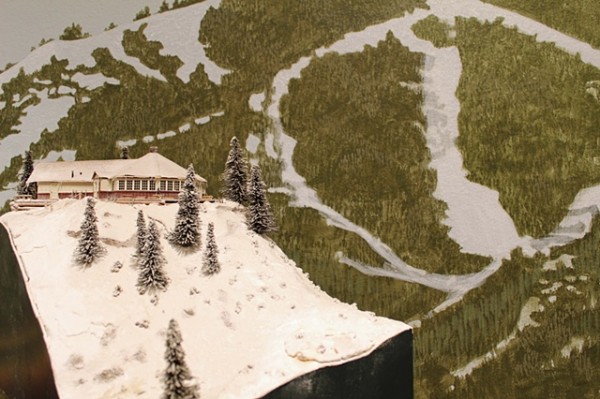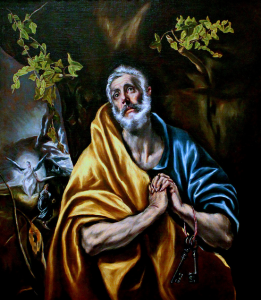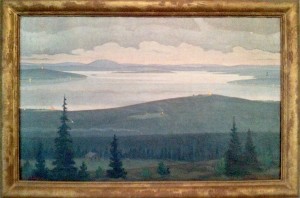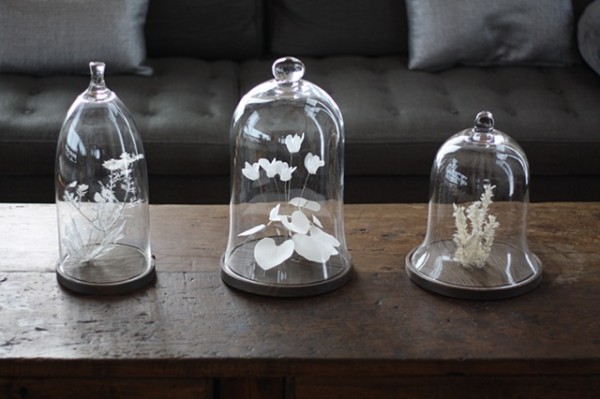detail from Sun Valley, by Amanda Hamilton
Recently I’ve been hearing some talk about the fall-out rate of female artists after giving birth. While I do not doubt that it happens, my own observation has been of a different demographic. Let us consider a more substantial statistic of women falling off the studio-practice bandwagon in the immediate exodus of those who, upon receiving their degree, do not find the wherewithal to stick to their craft.
I’ve seen a high percentage of students walk away from their studio practice before attaining a mature stage of work. I used to think that this was just part of the vetting process, but the casualties to the total women practicing in the visual arts is no small thing. The instance of those who trail off into unrelated territory out of school is partly due to a lack of encouragement to develop work at the onset of their career – untrained in the skills needed to maintain a quality studio practice, they throw in the towel. (Feel free to contradict me below in COMMENTS.)
The petering out that I have observed typically happens at the end of their studies or within a couple years following. Poor training and discipline, rather than specific personal life events, enhance the “starving” artists’ fatigue before they can sustain themselves. Setting a more rigorous standard of art-making can come from within a person, but is rarely developed without a mentor or teacher to inspire or direct it.
Still others simply find new interests to pursue, which may include a more singular focus on family life, among other things. It takes a lot to maintain a practice when we find ourselves pitted against other duties, so, it happens. But I think that the artist who is well equipped for their studio practice to begin with, who is making work with integrity – that is the artist who will continue to make work regardless of familial obligation or (what Betty Fridan would have called) sexual roles.
I’d venture to say that women who have become mothers after beginning a dedicated studio practice are more likely to find a way to make room for it in their life with children. Sometimes it takes on another form or style, but nevertheless is existant, and not only for the benefit of play in the home.
—
I met Amanda Hamilton eleven years ago, and although our acquaintance seemed brief, she left a lasting impression. When I met her she was working for the Art Department at my undergraduate university, and she has continued to teach and inspire. I am happy to share her story with you here as an example of a skilled exhibiting artist working with a variety of media; she is both a teacher and a mother. I can’t build up her work enough to you as she epitomizes the dedicated practitioner of the arts whose work has actively grown in its complexity over time.
—
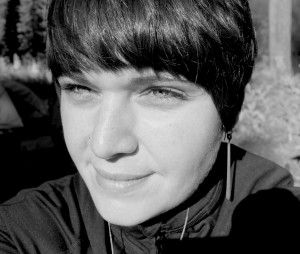
Amanda Hamilton
bk: First of all, tell me a bit about your roots, or where you come from?
AH: I grew up with two very different realities:
My mother’s parents were second generation Swedish immigrants to Los Angeles. They had done very well in the aluminum casting business and owned a factory downtown. The Swedish community they were part of still enacted a number of traditions and were all quite conservative, affluent Baptists.In contrast, my father grew up in Ohio and his parents were from rural Kentucky. Their generation had been the one that moved away from farming and into factory work. The tension between the dying farming communities and the industrialization and strip mining of that part of the country looms large in my family history. I have felt very tied to the KY farm all my life, and spent some time in the summers there as a child. I think this is where some of the really basic generative concerns about place, identity, nostalgia come from.
The two histories are wildly different both socially and economically, in terms of habits, norms and traditions… both very real and both very mine but exist in some form of opposition. As a young artist I was pretty obsessed with trying to reconcile these seemingly disparate experiences or realities.
All that being said, where is your current home?
Does your current environment influence your art practice?
My husband and I moved from Pasadena, CA to Boise, ID almost eight years ago. I took a position teaching drawing and painting and so we moved to Idaho within the span of a few weeks-cold.
I think my time in Idaho has certainly influenced my practice in the sense that there has been a lot of consideration of loss, continued investment in the question of the nature of experience… The early years here were quite lonely and any connection to personal history felt ripped away. It was like floating with no anchors- place, community, routine, even the well worn and boring path to the grocery store- gone.
Idaho is a very stark place with long summers and winters- Fall and Spring are compressed into these brief moments and it gives the year a sense of drama. The landscape itself is barren and desert for miles and then lush in the mountains and by the rivers. It was a foreign landscape and it took me some time to see the variations and even the beauty. And it is beautiful.
My practice has echoed this quiet empty space at times. There is a stillness. As a smaller city, it’s culturally quiet here and that was something I wanted in 2005/6 when we moved here from Southern CA.
Do you have themes that you contend with in your practice,
which have evolved out of early seeded ideas or experiences?
I think I spoke to this a bit earlier… I seem always to be thinking about the nature of things. I have always enjoyed philosophy and aesthetics. I like to think in a structured way about nuanced aspects of language or meaning.
I used to be obsessed with the questions of what is the real or what does it mean for something to be authentic. I have worked with scale models over the last ten years in large part as a stand in for this interest. I also seem to gravitate toward melancholy, loss, solitude, repetition or labor.
I’m not as interested in delineating boundaries or having an answer for things as I used to be. Now I see the work as asking better and better versions of those old questions, maybe making observations.
Does your Spirituality bleed into your artwork?
Can you describe for me any Spiritual ritual or practice that might be mimicked in a studio practice? Are these even related?
I don’t think of my “spirituality” and my “studio practice” as separate things. The person I am or am becoming is present in all moments of my life and is informed by all varieties of experience. My artwork is a form of spirituality- it’s where I ask questions and reflect.
My artwork requires the same integrity, dedication, thoughtfulness, that parenting does and that teaching does, that my marriage does. My posture to these things is not different but the specifics are…
As a discipline, what keeps you making artwork?
Is it driven from within you or is it more of an act of dedication?
Both.
I want to/ have the inclination to/ have learned to think this way… and sheer force of will moves me to completion on various projects. I have to be careful not to think or process faster than I work or I get bored and abandon projects.
What would you say brings you the most inspiration in life right now,
even if it does not reveal itself in your work aesthetically?
So many things…
My current studio space (solitude and a place that is not multi-use), everything about my daughter, I’m learning to do Pilates which is very challenging for me…but I am not giving up…maybe the “not giving up,” the fact that I’m not very successful, is inspiring.I read a good book of poems by Ben Lerner last spring called Mean Free Path and some aspect of the meaningfulness elevating itself above the acknowledgement of limitation of language and poetry and the process was really a big deal for me… artists should read it. It’s really influenced my choices in painting this year.
When my students take risks and really go for it in their studio practice- that’s pretty inspiring.
My family is moving to Minneapolis next summer and I am thrilled and inspired by starting our life there. I’ve become pretty close friends with a half dozen or so artist in Idaho whom I really admire- the studio visits and creative community have been really life-giving.
What was your first or most memorable interaction with a work of art?
I remember seeing an El Greco painting at the San Diego Museum of Art, I must’ve been in elementary school so maybe 9 or 10? I stared at it for a long time – I just couldn’t figure it out.
…I haven’t thought of that painting for years,
but your question brought it to mind.
I also grew up with paintings.
My great great great Swedish uncle was a painter and we have this oil painting of the summer solstice tradition of lighting massive bonfires by the edge of a Swedish lake. As a child I would write stories about the painting. I remember just staring at it forever.
I really worked up a belief that it was inhabited and that things could move within and beyond it. Especially the clouds. It was porous to me. I now have that same painting in my own home and like living with it.
Do you have any big projects in mind, or in the works?
I’m wrapping up some things I’ve been working at for about 3 years now. This work has to do with my time in Idaho, Marilynne Robinson’s book Housekeeping (which seems also to have been written about Idaho in a specific and vague sense) and ideas about process and tentativeness in art making and in life. The work includes painting, video, sound and objects. I’ll update my website in the next few months as the work is finished. I’ll get to show a bit of this work at Black Hunger in Boise this Fall and at the Olson Galleries at Bethel University in St. Paul this February.
One of the nice things about getting a little older is realizing it does take me 2-4 years to settle in with an idea. I spend a lot of time researching and thinking. I collect a lot of sounds, images, create models or shoot footage and at some point things start to gel materially in the same way the ideas have started taking shape. It’s nice not to stress out about how long this process takes for me- it’s just how I work. I know better how to plan for this longer process and how to commit to shows and other opportunities.
Once the current work is done (around December) I’ll start in on another project that I’ve been thinking about and working up to for the last year and a half. It has to do with a city in France at the end of the 19th century and my fictionalizing a collected history and my newly formed memories of it.
Is there something that you hope for the “art world” community?
I wish what I do for all people or communities… honesty, inquiry, dialogue, courage, kindness.
I guess my biggest “wish” in general is that people would have the guts to own what they think is good work or boring work and not take cues from major information outlets- have debates, people! There are already communities that do this, so I hope more people will adopt this way of being in the world.
And that artists would make what they truly want to make –stop thinking so hard – especially with graduate school’s burden of theory (though I love theory) – and stop putting what is fashionable first.
Move on to making things for the reasons you first wanted to make art.
Do you have any specific advice for artists who become parents?
I think it’s different for each person. In my experience, I found that the birth of my daughter was clarifying. I lost the ability to always be planning and preparing and moved more toward action in my practice. I think I did my best work after she was born because I couldn’t do things half-way. I felt I needed to go for it in the studio so I could get back to my family life.
I am grateful that my husband values my studio practice and at times has practically pushed me out the door to go work despite my sense of guilt. I think artist mothers have a unique sense of guilt- at least most of the ones I know do. So actually, here’s my advice:
Do not do this alone. Surround yourself with a few other artists who also value parenting… and talk. Know that it is harder to get time in the studio than if you had no child, or if you were single, or swimming in grant money, or wealthy and had no need of employment, but probably you are not many of those things and so find a way to do what you love.
I think of something Ghandi said that wasn’t about art but I’ve thought of a lot “actions express priorities”. I think we find ways to keep what we need in our lives- so you’ll find a way to make your art even if it’s terribly difficult.
And also, it’s okay to take a break from art production for a while! Read and think and go see shows. Everything doesn’t have to happen all at once.
Installation view of On Floriography, Amanda Hamilton
Amanda Hamilton holds degrees in Drawing and Painting from Biola and Claremont Graduate University, and has been regularly exhibiting work since finishing her undergraduate degree in 2000. She was a resident in the Painting’s Edge and Whale and the Star Summer Workshop. She has received several honors including a QuickFund$ grant through the National Endowment for the Arts. Ms. Hamilton has two exhibits scheduled to open over the next five months (at Black Hunger in Boise, ID, and at the Olson Galleries at Bethel University in St. Paul.)
Related Links :
www.amandahamiltonart.com
Originally published on www.bonniekate.com
